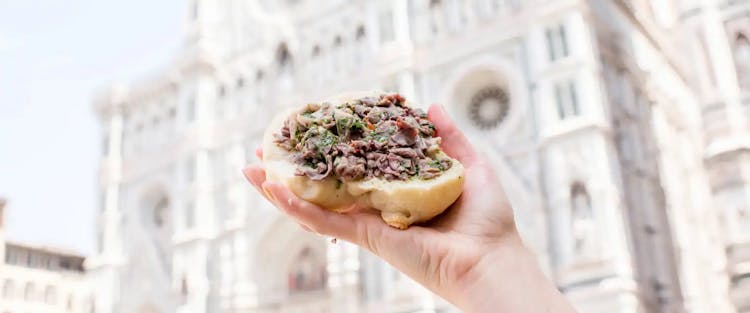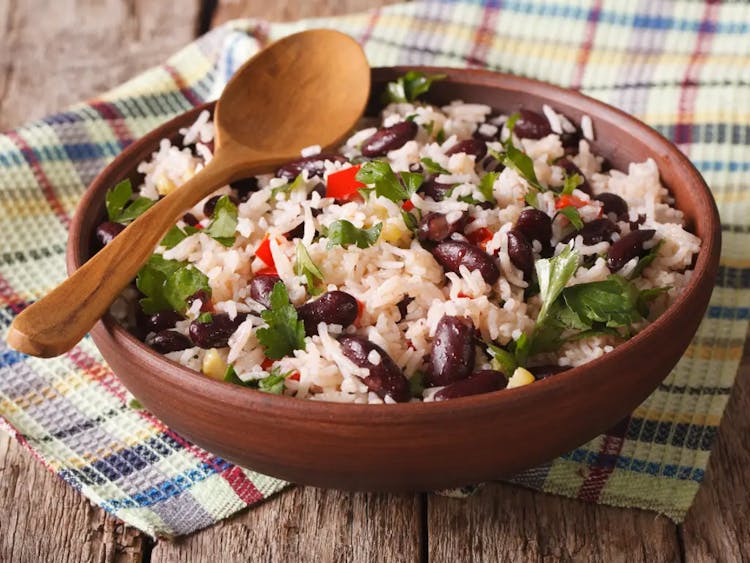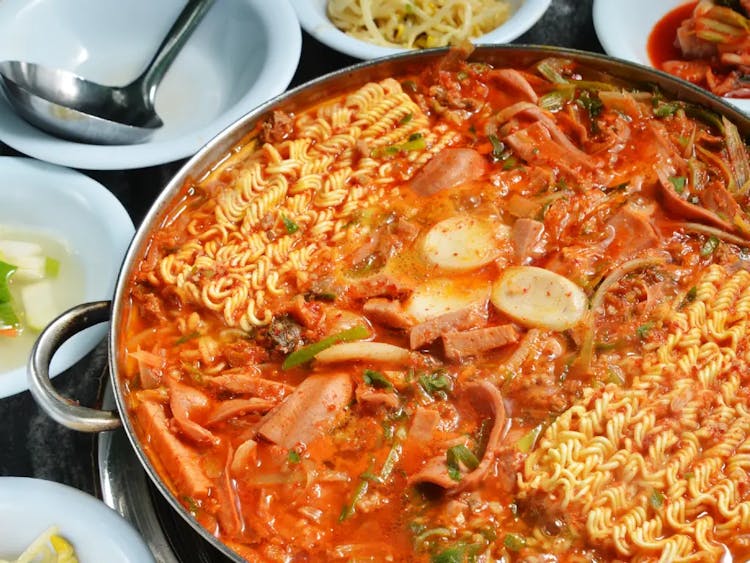
Mofongo: The Meaty Mash That Tells the Story of Puerto Rico
I’m bashing fried plantains and crispy pigskins into a mush using a pilón—the wooden, Puerto Rican version of a mortar and pestle. And though the pilón is small, it’s not easy. The pigskins, called chicharron in Spanish, are hard and resistant to pressure. Even the plantains, which look fairly soft, don’t want to be squashed.
I’m making mofongo, a quintessential Puerto Rican dish, with Pablo García, who leads Spoon Food Tours of San Juan, the island’s capital. But he explains I’m almost there. “Just keep adding butter and garlic sauce,” he says. “Then toss in the pork, turn your pilón upside down, and bang on it.”
Mofongo—a mouthwatering mash of crispy chicharron and fried plantains mixed with garlic and butter, served on its own, topped with, or layered around a center pile of meat—is hearty and filling. I’ve eaten heaps of it with beef, chicken, or pork; baked, grilled, or barbecued; or with seafood (my favorite) such as shrimp, lobster, or squid. But this is my first experience actually making the dish myself. After the first 15 minutes of vigorous mashing, my arms are tired. If you do it several times a day as a chef, you can probably skip the bicep workout in a gym.
“Usually, the chefs who work at Puerto Rican restaurants that specialize in mofongos are strong guys,” says Stephanie Haddock, a chef at Cocina Abierta in San Juan. Perhaps that’s why, despite Puerto Ricans’ love of the dish, not everyone makes it very often. It takes too much energy and vigor, Haddock says. “That’s why we don’t usually say, ‘let’s make mofongo tonight.’ We say, ‘let’s go eat mofongo tonight.’”
Still, some Puerto Ricans do make their own mofongo. “I make it with my mom,” says Davelyn Tardi, a Puerto Rican and huge mofongo fan. Her family takes great pride in mashing their homemade mofongos, whether for special occasions or everyday dinners. “Puerto Ricans consider this dish our culinary heritage,” she adds.
Ingredients that tell a story

Mofongo’s roots trace back to when the Spaniards brought enslaved Africans to work on the island’s plantations, food historian Cruz Miguel Ortíz Cuadra writes in his book, Eating Puerto Rico: A History of Food, Culture, and Identity. Exactly when mofongo arrived at the island isn’t known, but it was likely in the 1500s.
“The various Angolan ethnic groups who populated the island employed […] the technique of using a mallet to mash great quantities of starchy foodstuffs and softened the mixture by adding liquids and bits of fat,” Cuadra writes, adding that the name was African too. “The word mofongo appears to stem from mfwenge-mfwenge, an Angolan-Kikongo term that means a great amount of anything at all.” Meanwhile, the noun “mfwongo” meant “plate” or “flat surface,” and related to the acts of crushing or mashing.
The local Taino people, the island’s original inhabitants, adopted the recipe from the Angolans. The addition of garlic likely came from Spanish cuisine. “So mofongo is like the baby of the colonization in Puerto Rico,” Haddock says.
The dish was also cheap to make as plantains grew in abundance, and pork skin was often a leftover. Cuadra writes that in its early iterations, it was made in ”enormous mortars in the slave quarters to feed a great many people at the same time.”
Eventually, the tasty, filling dish appealed to the higher classes. The dish’s first official recipe debuted in the 1859 cookbook El Cocinero Puerto-Riqueño o Formulario. In 1948, it was featured in the Puerto Rican Cookbook and two years later in Cocine a Gusto, firmly rooting itself as the island’s staple. There are no stats on how many mofongos are savored every year, but it’s likely in the millions. “I eat one every other day,” Tardi says.
Mofongo, trifongo, and more

Over the years, mofongo has acquired some variations. Oil or chicken stock can be used instead of butter to bind the mash. Some chefs also smash different kinds of starchy veggies—for example, yuca or sweet plantains instead of green ones. If you use yuca and the sweet and green plantains all together, that becomes a trifongo, says chef Gerardo Davila, who serves it at Mercado la Carreta in San Juan. The trio is a great vegetarian option—its richness allows chefs to skip the chicharron and meat. Some chefs use veggies or cheeses as toppings to enhance flavors, Carillo says.
Island geography adds variety, too. “In the middle of the island, it’s more common to eat mofongo with pork or meat, but on the west part of the island, it’s more common to eat it with seafood,” says Tardi. “And in the north, you get both.”
In his book, Guadra writes that the 20th-century Puerto Rican cookbooks featured recipes for using mofongo as a stuffing for chicken and turkeys. Some chefs serve such mofongo-stuffed poultry today. “We make mofongo-stuffed chicken breasts, which we cook with garlic cream,” says Davila.
Haddock’s restaurant, Cocina Abierta, also has its own unique spin on the timeless dish. “Instead of butter, we use duck fat. Instead of pork rinds, we fry duck skin—we essentially make our own chicharron,” she says. “And then we serve it with duck confit for meat.”
Many iconic dishes draw fierce controversies about the right and wrong way to eat them—and so does mofongo. In this case, the culprit is MayoKetchup, a pink gooey mix of both condiments and the island’s favorite sauce. “We Puerto Ricans love MayoKetchup; we put it on everything,” says Haddock. But mofongo is where many people vehemently disagree. Some say that MayoKetchup makes the dish better, while others insist it destroys the true mofongo flavor.
Tardi loves her mofongos sans MayoKetchup while her friends take the opposite side. “We argue about it all the time when we go out to eat mofongo,” she says. MayoKetchup is as classically Puerto Rican as the plantains and pig skins, so “most restaurants would serve mofongos with a side of MayoKetchup, and my friends love it that way.”
Culinary professionals tend to fall into the latter category. “Many chefs feel that if they spend time and effort making you a perfect mofongo, why would you smear it with MayoKetchup?” Davila says. “All you really need to eat a well-prepared mofongo is a fork.”
Where to get your mofongo fix
- Iguanas Cocina Puertorriqueña at the Wyndham Grand Rio Mar hotel serves classic mofongos against the backdrop of stunning views of the golf course and rainforest.
- Perfectly cooked and beautifully presented, the duck mofongos can be sampled at Cocina Abierta in San Juan.
- With two locations in San Juan, Mercado la Carreta serves delicious mofongo-stuffed chicken breasts.
- Grab seafood mofongo at Moons Bar & Tapas in La Parguera or Caddy’s Calypso cafe on Maria’s Beach in Rincón.
- For mofongo beloved by the locals, check out Deaverdura, La Casita Blanca, or La Parilla.
Plan your trip to Puerto Rico
Known as La Isla del Encanto, or The Island of Enchantment, Puerto Rico is dotted with natural wonders like rainforests and mountains, islands ringed in white sand, and nearly 300 beaches. Read more about the island or get the scoop on San Juan.
Join Going and get cheap flights and travel tips dished up right to your inbox.
Read more about delicious dishes around the world:
Published June 15, 2023
Last updated December 19, 2023
Treat your travel to cheap flights
Most deals are 40-90% off normal prices with great itineraries from the best airlines. If it's not an amazing deal, we won't send it. Sign up for free to start getting flight alerts.




